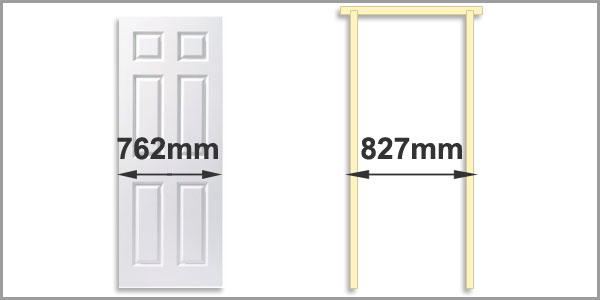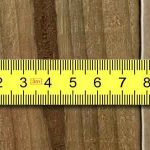A door lining is a timber frame, similar to a casing, that is installed in a door opening.
It can be left as a lining with no door, or it can have pieces of wood attached, to form a rebate. This will mean a door can be hung in the lining.
There isn’t one standard size for a door lining. The size is usually determined by the size of the door you will be hanging in it.
The most common door size in the UK is 1981 x 762mm. In general, a lining has a finished thickness of around 27-30mm. You will also add around 5mm to account for gaps between the door and lining.
Therefore, a standard lining for a 762 door, will be roughly 821 – 827mm wide to the outside edge. Height will be between 2010mm and 2020mm. Again, this is the measurement to the outside of the frame.
If you are creating an opening for this lining (in a stud wall for example), you should leave an additional 20mm for packing and fitting.

Different door sizes
There are several different door sizes available in the UK. Some of the most common can be seen below:
- 1981 x 457
- 1981 x 533
- 1981 x 610
- 1981 x 686
- 1981 x 762
- 1981 x 838
- 2040 x 626
- 2040 x 726
- 2040 x 826
As we mentioned previously, the most common is 1981 x 762. However, smaller sizes are often used where space is tighter. For example small cupboards, bathrooms, etc.
It is also quite common to find wider door openings, especially in older properties.
In many cases, when you buy a lining, the head will already have trenches notched out for the correct door size. These trenches are for the legs to slot in too, and they give the inside measurement for the lining. This will usually allow approximately 5mm more than the width of the door (767 for a 762 door).
To fix your lining together, you simply add wood glue into the trenches, and fix two screws through the head into each leg
Another common feature is a reversible head. This means a lining can potentially be used for 2 different door sizes. For example, one side may be designed for a 762mm and the other could be designed for a smaller 686mm door.
You can also buy untrenched linings, which will allow you to determine the opening size yourself. These can be useful if your door is not a standard size.
Regardless of the door size, the way you work out the lining size will always be the same. Essentially, you just need to add the thickness of the frame, plus the gap for the door. If your frame is 30mm thick, then you simply add 65mm (30+30+5). This will give you the full width.
For the height, add the frame thickness + around 5-10mm to account for a small gap at the top and some space at the bottom for flooring. It doesn’t hurt to have a smaller gap at the bottom initially. However, you may need to shorten your door when flooring is installed.
Difference between a door lining and a door casing
The main difference between a door lining and a door casing, is a casing has a machined rebate for the door stop. This rebate is usually around 12mm x 35-40mm for a standard internal door. This is a machined rebate, so it is not adjustable.
On the other hand, a lining has a flat internal face with no rebate. An attachable doorstop lat is provided with the frame. This is usually around 12x32mm and can be nailed to the lining in order to create a rebate.
Both casings and linings have their own personal advantages. For a casing they are slightly thicker and more robust. Plus they also look nicer as it is one solid piece.
However, a lining also has several advantages. These include:
- You can add a plain lining – Sometimes you will want to add an opening with no door. In this scenario you don’t want a rebate. Therefore, a lining will give a much neater finish.
- A lining can be adjusted to different door thicknesses – As we mentioned 30-45mm is common for internal doors. A loose stop provided with a lining can be adjusted to fit both.
- It can be adjusted to fit your door better – Not every opening is completely plum and perfect when hanging a door. Whilst you should be aiming to hang the door as perfectly as possible, a movable stop can come in handy. If you have a slight gap cause by twist in the door casing, The stops can be adjusted slightly to make your door close perfectly into the rebate.
Door linings for different wall width
The last thing to consider when buying a lining, is the wall width, as this will affect how wide your lining legs and head need to be.
There are many things that can affect the thickness of a wall. For example:
- Is it a solid wall or studwork?
- If it’s a solid wall, is it boarded or plastered straight onto the masonry?
- Is it double boarded for fire safety?
- How thick is the studwork (usually 75mm or 100mm)?
- Is there a thicker material, such as insulated plasterboard being used?
- Etc
All of the above, plus many other reasons, could affect a walls thickness. Ideally, your lining should be flush with the finished wall. This will allow architrave to sit flat, overlapping the door lining, and the surrounding wall.
You don’t want any steps between the wall and the lining, as this will cause gaps, which will result in a poor finish.
Lining thicknesses commonly range between 95-200mm. The most common sizes, will consider the thickness of studwork timber, plus plasterboard thickness on each side, and a few mm of skimmed plaster.
To ensure you get the right thickness, you will need to measure the wall yourself. If your wall is not a standard thickness, you can buy a slightly thicker frame and plane it to fit.
Conclusion
As you can see, there isn’t a one size fits all for door linings. The size you use, will be based on the opening size, the door size, and also the thickness of the wall you are fitting into.
As a general rule, you can add roughly 65mm to a standard door size, to determine how wide your door lining will be.
If you already have an opening, where your lining will be fitted, you simply need to find a lining that fits in the opening. This should include a little wiggle room for packing, in order to fit your lining plumb.
If you are creating a door opening, make sure to leave an extra 20mm for the same reason. You do usually need some wiggle room for packing. This will ensure the lining is fitted completely plumb, and free from any twist.




